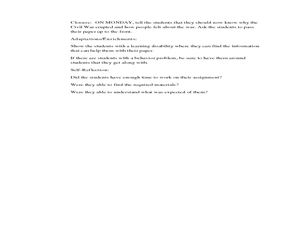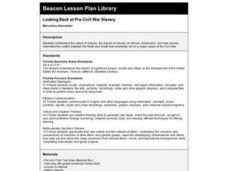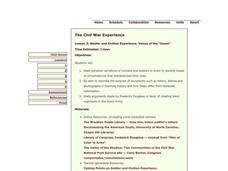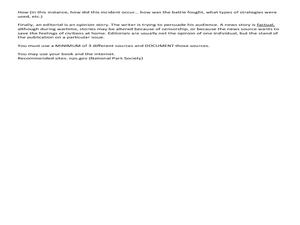Curated OER
Political and Social Origins of the Civil War
Middle schoolers examine the difference in politics in the North and South during the Civil War. Using that information, they discuss how politics and ideologies led to the war. They explain the causes and effects of the war and evaluate...
Curated OER
Experiencing the Civil War
Eleventh graders examine the Civil War. In this American History lesson, 11th graders investigate the causes, effects, and the lives of people during the Civil War. Students develop a research paper using various resources.
American Battlefield Trust
Pre-1861: Disunion
Nat Turner, John Brown, and Abraham Lincoln all played a key role in the run-up to the bloody American Civil War. Using a PowerPoint, timeline activity, and essay prompt, young historians consider the roles of these men and more to...
Curated OER
Looking Back at Pre-Civil War Slavery
Eighth graders explain the nature of slavery, the impact of slavery on African-Americans, and how slavery intensified the conflict between the North and South that eventually led to a major cause of the Civil War.
Curated OER
The Civil War Experience
Eighth graders study the Civil War. In this Civil War lesson, 8th graders read and analyze primary sources. Students complete handouts in relation to the primary sources.
American Battlefield Trust
John Brown
How did the raid on Harper's Ferry contribute to the start of the Civil War? Curated for high school historians, the activity explains John Brown's contribution to the start of the Civil War by using violence to demand an end to slavery....
NET Foundation for Television
1850-1874 The Kansas-Nebraska Act
How the Kansas-Nebraska Act created Bleeding Kansas is complicated—until scholars research and examine documents from the time. After completing activities that include mapping, photo, document analysis, and discussion, learners...
American Battlefield Trust
Pre-1860: Disunion
Using personas ranging from freed African Americans to wealthy plantation owners, young historians consider various points of view around the events in the days leading up to the Civil War including major milestones such as the Dred...
School Improvement in Maryland
Court Proceedings Civil Cases
What's the difference between civil and criminal law? How do the court proceedings differ in these two types of trials? How do the standards of proof differ? Why do these differences exist? As part of their examination of the US court...
Stanford University
Fort Sumter
The headlines screamed what everyone knew was coming: War! While Fort Sumter was considered the first battle of the Civil War, the engagement played differently in newspapers at the time. Using coverage from Northern and Southern...
K20 LEARN
Deconstructing Reconstruction: The Reconstruction Era
High schoolers examine the Reconstruction programs instituted following the American Civil War, the potential for change these efforts offered, and the realities that occurred. Guided by a PowerPoint presentation, class members read a...
Curated OER
What price Freedom! Civil War and Reconstruction
Fifth graders become familiar with the events of Reconstruction and the 13th, 14th, and 15th amendments. In this reconstruction lesson plan, 5th graders work in pairs where each student creates a building with blocks and draws it. Their...
Curated OER
Slavery, Manumission, and Freedom: Free Blacks in Charleston before the Civil War
Learners explore the concept of slavery and manumission through a variety of activities. In this civil rights lesson, students gather information from primary sources, then analyze the politics and historical context of the time....
Curated OER
Lesson Plan on Important Citizens in the American Civil War
Students, in groups, half representing the Confederacy, half the Union, conduct research to find out about important Civil War era citizens from each side. They explore the effect these people had on the war and what effect the war had...
Curated OER
Lesson Plan on Military Leaders in the American Civil War
Young scholars, in groups, half representing the Confederacy, half the Union, conduct research to find out about important Civil War military leaders from each side. They find the answers to a variety of questions regarding their...
Curated OER
Hoosier Soldiers and the Emancipation Proclamation
Eighth graders examine the impact of Lincoln's Emancipation Proclamation through the eyes of Indiana soldiers. In this American Civil War lesson plan, 8th graders read the proclamation and then students write essays that included letters...
Curated OER
Reporting on a Battle
Young scholars report on battles of the Civil War. In this American Civil War lesson, students conduct research that allows them to report on selected battles of the war. Student's newspapers should include eyewitness statements,...
Curated OER
Japanese-American Relocation
Consider the causes and effects that led to the internment and relocation of Japanese Americans during WWII. Learners read the story "Baseball Saved Us" and selected chapters from Farewell to Manzanar. Then, they view a slide-show, and...
Curated OER
AFRICAN-AMERICAN POETRY BEFORE EMANCIPATION
Explore poetry written by African-Americans before emancipation. 8th graders create collages, and explain why they chose specific stanzas. They display the collages on the class bulletin board that demonstrate an understanding of the...
American Battlefield Trust
Contrasting the North and South Before the War
Fundamental differences between the North and South led to the South adopting a system of enslaved labor. These abstract ideas become concrete when class members create a standing cube using information provided in the resource. Young...
Curated OER
A Nation Divided: Why Couldn't They Just Get Along?
Fourth graders examine both perspectives of the Civil War as related to the differing economies. In this nation divided lesson, 4th graders view primary sources, examine paper money and a political chart, and review recruitment posters.
National History Day
“Saving the Bear”: The Russian Expeditionary Force of World War One
How have Russian politics affected countries on a global stage? The discussion of the Russian Revolution and World War I begins with an analysis of primary resource letters. Learners finish with a project where they create a timeline of...
Curated OER
Brutal British
Students read and predict the outcome of a story set during the Civil War, then map the story. To prepare for the activity, students determine why it is important to look at historical events from all angles by using primary and...
Curated OER
Election of 1860
Young scholars determine how the presidential election of 1860 led to the American Civil War. In this election of 1860 lesson, students discover details regarding the election and hold their own mock debate and election. Young scholars...

























